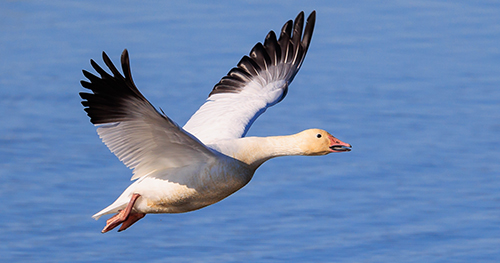BY HARRY WEEKES
This fall, I read two books that explored natural history through the lens of how other animals see, hear, taste, touch and smell. The books focused on the vast worlds of other organisms and how those animals interact with their environments.
So, the senses have been on my mind, and the last couple of weeks have provided wonderful circumstances to fuel my mulling.
As always, the first dusting of snow highlights so much of what is out there. The rabbit tracks in the driveway. That lone arc of prints that crosses the open field in Indian Creek. The snowy hoofprints of the elk at their various crossings on Buttercup. Yes, I am seeing these creatures, but only the spoor that they leave; the evidence that they were here.
My default to the visual is obvious, so what about those things that we never see? Like the snow geese on Thanksgiving. Who woke up to the tens of thousands of birds flying over the valley? Depending on reports, the geese flew over from midnight until four or five in the morning, a chorus of continuous honking so loud it woke people up, drew them out into the streets, and, for some, sent them into an aurally-driven quest to find out where these things were going to land. As darkness often does when accompanied by thousands of avian voices, the honks came from everywhere and nowhere. The only secondhand report I heard is that a group of the birds landed in a field in Picabo.
What a wonderful little natural history mystery this was. Was this the first time this happened? Why were the geese crossing over here, now? Where were they headed? Was there some kind of storm? Or confusion amongst the birds? The answer to all of these is the same—“We will never know.” What I am fairly certain of, though, is there was purpose. Accidental or not, there was intention amongst the geese.
The third sensory event happened as I waded out into the ocean and promptly stepped on something sharp and hard, but definitely alive. Immediate possibilities came to mind—there was a puffer fish carcass on the beach, could it have been one of those? What about some kind of clam or oyster or bivalve with their notoriously sharp shells? However, there was something else in the millisecond my foot compressed the “thing.” I don’t know if it was the resistance, that the beast moved too, or that I picked up some sense of the creature’s anatomy as it nicely sliced my toe, but if I had to guess, I would say it was some sort of a crab. Ultimately, I will never know.
As much as I would love to explore the world in the way that other animals do, I am currently working on refining the senses that I do have. Sharpening my vision as I look at the scattered tracks in the snow of the gray partridge covey that skittered, bounced, flitted, and flew through the backyard. Working to discriminate the voices of the pack of coyotes that moved through Quigley in the beginning of December. Feeling the different temperatures on my morning walk. And just this morning, wondering, can you taste a coming storm?
Needless to say, I have a lot of work to do. For now, I will content myself with reviewing the audio files of snow geese and that the wound on my toe has healed. Also knowing that each of the senses, however limited mine may be, seems connected to a boundless world of questions, a curiosity that appears to be some kind of sense of its own.
Harry Weekes is the founder and head of school at The Sage School in Hailey. This is his 52nd year in the Wood River Valley, where he lives with Hilary and one of their three baby adults—Simon. The other members of the flock are Georgia and Penelope (Georgia recently fledged from Davidson College in North Carolina and Penelope is at Middlebury College in Vermont).



